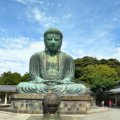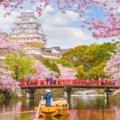Are you planning a trip to Kyoto and want to make the most of your time? This 3-Day Kyoto Itinerary is your ultimate guide to experiencing the city’s breathtaking temples, serene gardens, and deep cultural heritage. As one of the best destinations in Japan, Kyoto seamlessly blends history, tradition, and stunning scenery.
Whether you’re a history enthusiast, a food lover, or simply someone who enjoys exploring beautiful places, Kyoto promises an unforgettable adventure. This itinerary is designed to help first-time visitors easily navigate the city while uncovering its must-see attractions, hidden gems, and incredible local cuisine.
Get ready for three unforgettable days filled with awe-inspiring sights, mouthwatering food, and immersive cultural experiences!
If Kyoto is just one stop on your Japan trip, check out our Japan Itinerary for First-Timers to see how to fit Kyoto into a 10-day adventure covering Tokyo, Kyoto, and Osaka.
For a visual journey through Japan’s top destinations, don’t miss the YouTube video “Top 10 Best Places to Visit in Japan”. It showcases some of the country’s most breathtaking spots, giving you a sneak peek at the incredible places you’ll want to add to your bucket list!
Table of Contents
Day 1: Exploring Eastern Kyoto – A Journey Through Culture and Tradition
Your first day in Kyoto is all about immersing yourself in the city’s rich cultural heritage. You’ll explore some of its most iconic temples, stroll through historic streets, and experience the elegance of Kyoto’s geisha district. Wear comfortable shoes, as you’ll be walking a lot!
Morning: Discover the Charm of Higashiyama
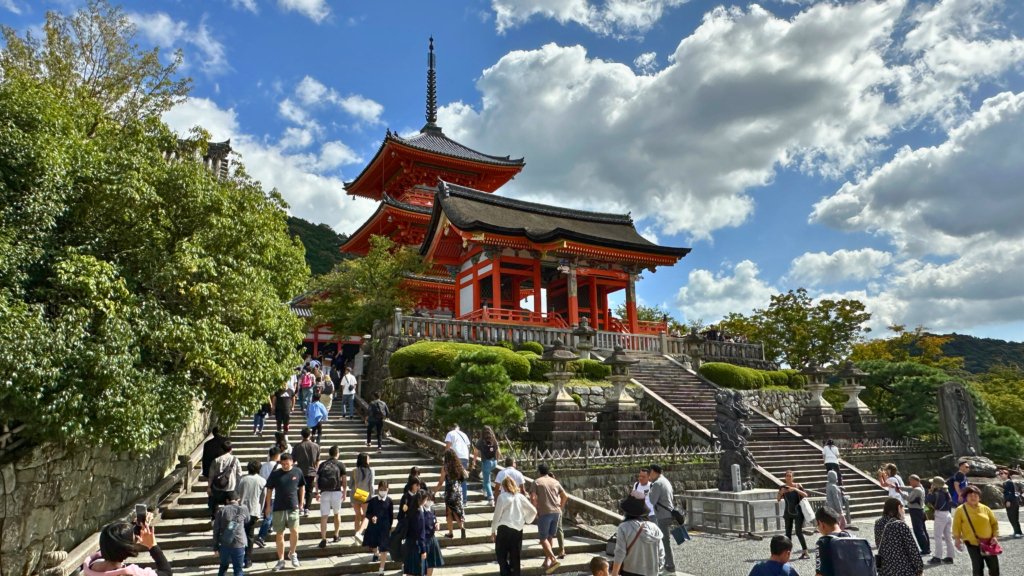
Start your journey at one of Kyoto’s most celebrated landmarks, Kiyomizu-Dera Temple. Perched on a hillside, it offers spectacular panoramic views of the city, especially during cherry blossom season in spring and the fiery maple foliage of autumn. Walk along the famous wooden stage, an architectural marvel built without nails, and take in the breathtaking scenery.
Be sure to visit the Otowa Waterfall, where visitors drink from three separate streams, each believed to bring a unique blessing: Longevity, Success in studies and Love and relationships.
💡 Tip: Arrive early (before 9:00 AM) to avoid large crowds and capture the best photos.
As you leave Kiyomizu-Dera, walk down Sannenzaka and Ninenzaka, two of Kyoto’s most picturesque streets. These beautifully preserved lanes, lined with traditional wooden machiya townhouses, tea houses, and artisan shops, offer a glimpse into Kyoto’s past.
What to Do on Sannenzaka and Ninenzaka:
• Stop by local stores selling handcrafted ceramics, kimonos, and Kyoto-style souvenirs.
• Grab a matcha soft-serve ice cream or try yatsuhashi, Kyoto’s famous cinnamon rice sweet.
• Visit the Starbucks in a traditional teahouse, the only one of its kind in the world!
📸 Photo Spot: Capture the iconic view of Yasaka Pagoda framed by sloping rooftops—a must for any Kyoto itinerary!
Afternoon: Temple Hopping and Scenic Walks
Philosopher’s Path – A Tranquil Riverside Walk
After lunch, take a relaxing stroll along the Philosopher’s Path, a charming 2-kilometer walkway following a narrow canal. Lined with cherry blossom trees and small temples, this path is named after philosopher Nishida Kitaro, who used to walk and meditate here.
🌸 Best Time to Visit: Spring for cherry blossoms, autumn for vibrant foliage
☕ Nearby Cafés: Stop at a cozy tea house for warm matcha and traditional sweets cup.
🚶 Walking Distance: 2 km (~30 minutes, plus time for temple visits)
Ginkaku-ji (Silver Pavilion) – Kyoto’s Subtle Elegance
End your afternoon at Ginkaku-ji, a stunning Zen temple known for its minimalist beauty and perfectly manicured gardens. Unlike its golden counterpart, Kinkaku-ji, the Silver Pavilion remains unadorned, embracing Kyoto’s refined aesthetic.
What to See:
• The Sea of Silver Sand – A meticulously raked sand garden designed to reflect moonlight.
• The Moss Garden – A lush green sanctuary perfect for contemplation.
Evening: Gion District and Kyoto’s Traditional Cuisine
Gion – Kyoto’s Geisha District at Night
Head to Gion, Kyoto’s legendary geisha district, as the sun sets. Stroll along Hanamikoji Street, where you might catch a glimpse of a geisha or maiko (apprentice geisha) gracefully making their way to an evening engagement.
✨ Highlights:
• Walk past traditional wooden tea houses (ochaya) and atmospheric lantern-lit streets.
• Stop by Yasaka Shrine, which is beautifully illuminated at night, adding to the district’s charm.
• Visit Shirakawa-dori, a quieter, less touristy street in Gion, lined with historic townhouses and a peaceful stream.
💡 Tip: Be respectful—avoid taking close-up photos of geisha without permission, as it disrupts their work.
Dinner: Experience Kyoto’s Exquisite Kaiseki Cuisine
Wrap up your first day with an authentic kaiseki dinner, a multi-course meal that showcases Kyoto’s seasonal flavors and artistic presentation.
🍽 Recommended Restaurant: Gion Karyo
💰 Price Range: 6,000 – 12,000 yen per person
🥢 Dish Highlights: Yuba (tofu skin), tempura, grilled fish, and seasonal delicacies.
Alternatively, if you prefer a more casual option, try Ramen Muraji (Gion Branch) – A cozy spot serving Kyoto-style ramen with a lighter, refined broth.
Day 1 Recap: A Perfect Start to Kyoto
✅ Marvel at the panoramic views from Kiyomizu-dera Temple
✅ Wander through the historic streets of Sannenzaka and Ninenzaka
✅ Take a serene walk along the Philosopher’s Path
✅ Explore the minimalist beauty of Ginkaku-ji
✅ Experience the magic of Gion at night
✅ Savor an authentic Kyoto-style dinner
After a day filled with stunning temples, charming streets, and cultural experiences, you’ll be ready for the adventures that await on Day 2 of your Kyoto itinerary!
Day 2: Northern and Western Kyoto – Temples, Bamboo Forests & Scenic Views
Your second day in Kyoto takes you on a journey through majestic temples, serene Zen gardens, and breathtaking natural landscapes. From the golden splendor of Kinkaku-ji to the soothing bamboo groves of Arashiyama, today’s itinerary perfectly blends history and nature. Be ready for a mix of walking, exploration, and stunning scenery at every turn!
Morning: The Golden Pavilion and Zen Gardens
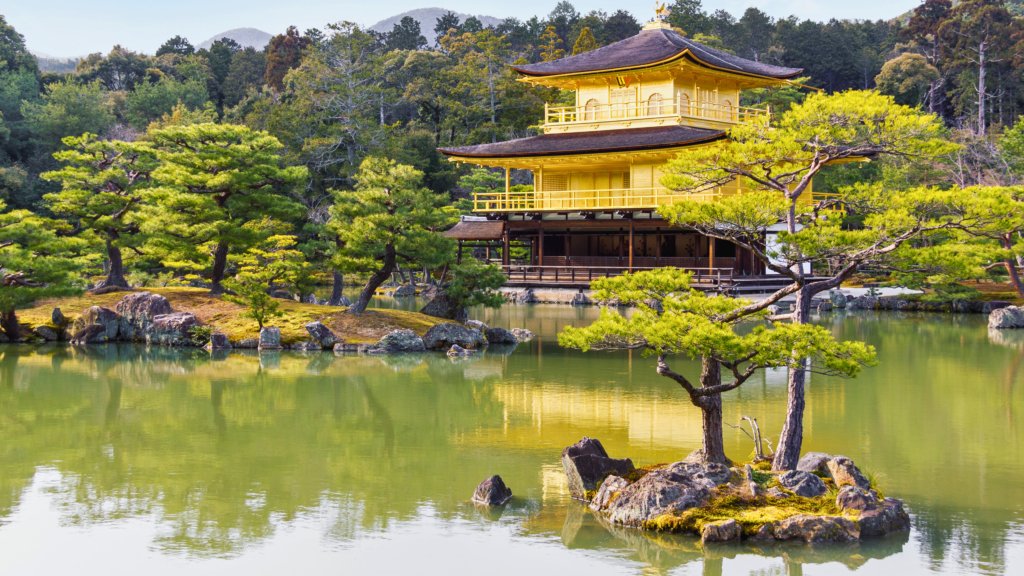
Kinkaku-ji (Golden Pavilion) – Kyoto’s Iconic Landmark
Start your day at Kinkaku-ji, one of Kyoto’s most famous and picturesque temples. Covered in brilliant gold leaf, this UNESCO World Heritage Site is a true masterpiece, reflecting elegantly on the mirror-like Kyoko-chi Pond. The meticulously designed gardens surrounding the temple enhance its tranquility, making it an absolute must-visit.
📸 Photo Tip: Arrive early to capture the best reflections of the temple in the pond before crowds arrive.
Ryoan-ji Temple – The Art of Zen Simplicity
Just a short distance from Kinkaku-ji, Ryoan-ji Temple is home to Kyoto’s most famous rock garden, a masterpiece of Zen aesthetics and meditation. The garden features 15 carefully placed rocks set in a sea of white gravel, designed to inspire deep contemplation. Interestingly, no matter where you sit, you can never see all 15 rocks at once, symbolizing the idea of incomplete beauty in Zen philosophy.
💡 Tip: Take a moment to sit in front of the rock garden and experience the tranquility and mindfulness that Zen culture embodies.
Afternoon: Arashiyama Bamboo Forest & Temples
Arashiyama Bamboo Grove – A Walk Through Nature’s Magic
After lunch, head west to Arashiyama, a district famous for its breathtaking natural beauty. One of its most mesmerizing spots is the Arashiyama Bamboo Grove, where towering bamboo stalks sway gently in the breeze, creating a dreamlike atmosphere. Walking through the grove feels almost otherworldly and provides one of Kyoto’s most iconic photo opportunities.
📸 Photo Tip: For the best experience, visit early in the morning or late in the afternoon when the crowds are thinner.
Tenryu-ji Temple – A Zen Masterpiece with Stunning Gardens
A short walk from the Bamboo Grove, Tenryu-ji is a UNESCO World Heritage Site and one of Kyoto’s most important Zen temples. The highlight here is its beautifully landscaped garden, designed by Muso Soseki, which features a large reflective pond framed by seasonal foliage and the distant Arashiyama mountains.
🌸 Best Time to Visit: The garden is stunning every season, from cherry blossoms in spring to fiery maple leaves in autumn.
Monkey Park Iwatayama (Optional Activity for Adventure Seekers)
If you’re up for a short hike and a bit of wildlife spotting, head to Monkey Park Iwatayama, where you can see wild Japanese macaques roaming freely. The 20–30 minute uphill hike rewards you with a stunning panoramic view of Kyoto at the top.
🐒 What to Expect:
• Get up close to wild macaques in a safe, open environment.
• Enjoy breathtaking city views from the observation deck.
• Bring cash if you want to feed the monkeys!
📍 Hiking Time: 20–30 minutes (moderate difficulty)
Evening: Scenic Dining by the Katsura River
After a full day of exploring Kyoto’s breathtaking temples and nature spots, unwind with a traditional dinner by the Katsura River. The Arashiyama district is known for its yudofu (tofu hot pot), a simple yet flavorful Kyoto specialty.
🍽 Recommended Restaurant: Shoraian (Tofu Kaiseki Cuisine)
Nestled in a peaceful riverside setting, Shoraian offers a refined kaiseki-style tofu meal that highlights Kyoto’s delicate flavors.
💰 Price Range: 3,000 – 8,000 yen per person
🥢 Must-Try Dishes: Tofu hot pot, seasonal Kyoto vegetables, and light tempura
Before calling it a night, take a leisurely stroll across Togetsukyo Bridge, a historical wooden bridge that spans the Katsura River. At sunset, the soft golden glow over the river and surrounding mountains creates a magical scene that perfectly ends your Kyoto day.
📸 Photo Tip: Capture the bridge against the backdrop of the illuminated mountains for a postcard-perfect shot.
Day 2 Recap: A Day of Kyoto’s Iconic Beauty
✅ Admire the golden splendor of Kinkaku-ji
✅ Experience Zen meditation at Ryoan-ji’s rock garden
✅ Walk through the enchanting Arashiyama Bamboo Grove
✅ Explore the serene gardens of Tenryu-ji Temple
✅ Meet wild monkeys with a city view at Iwatayama (optional)
✅ Enjoy a riverside tofu kaiseki dinner in Arashiyama
✅ Watch the sunset over Togetsukyo Bridge
After a day filled with history, nature, and unforgettable Kyoto experiences, get ready for your final adventure on Day 3 of this perfect Kyoto itinerary! 🚀
Day 3: Southern Kyoto & Cultural Experiences – A Perfect Finale
For your final day in Kyoto, immerse yourself in the city’s imperial history, sacred shrines, and refined cultural traditions. You’ll explore one of Japan’s most iconic landmarks, walk through beautifully preserved castle grounds, and experience an authentic Japanese tea ceremony before wrapping up your journey with an unforgettable kaiseki dinner.
Morning: Fushimi Inari Taisha – A Walk Through Kyoto’s Iconic Torii Gates
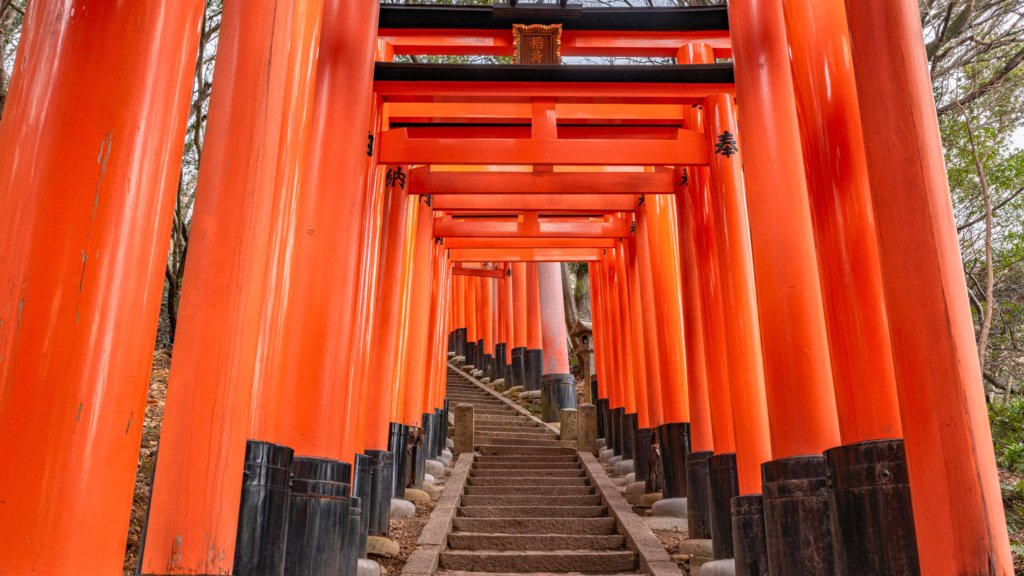
Start your morning at Fushimi Inari Taisha, one of Kyoto’s most recognizable and mesmerizing shrines. Dedicated to Inari, the Shinto deity of rice, prosperity, and business success, this sacred site is famous for its thousands of vermilion torii gates, creating a spellbinding tunnel that winds up Mount Inari.
🌿 Hiking Time:
• The full hike to the summit takes 2–3 hours.
• If short on time, walk through the lower sections, which offer fantastic photo opportunities in 20–30 minutes.
💡 Tip: Arrive before 8:00 AM to avoid crowds and experience the peaceful atmosphere of the shrine.
Afternoon: Nijo Castle & Kyoto Imperial Palace – A Journey Into History
Discover the Feudal Majesty of Nijo Castle
Next, head to Nijo Castle, a UNESCO World Heritage Site and one of Kyoto’s most historically significant landmarks. Built-in 1603 as the residence of Tokugawa Ieyasu, the first shogun of the Edo Period, the castle is renowned for its:
• Ninomaru Palace, featuring the famous “nightingale floors”, which chirp underfoot as a security measure against intruders.
• Exquisite gold-leaf interiors and intricate wood carvings showcasing the power and opulence of the Tokugawa shogunate.
• Beautifully landscaped gardens, particularly stunning in spring with cherry blossoms and in autumn with vibrant foliage.
💡 Tip: Take your time exploring the castle gardens, especially if visiting during cherry blossom or autumn foliage seasons.
Step into Kyoto’s Imperial History at Kyoto Imperial Palace
A short distance from Nijo Castle lies the Kyoto Imperial Palace, the former residence of Japan’s imperial family before the capital moved to Tokyo in 1869. Although the royal family no longer resides here, the palace offers a fascinating glimpse into Japan’s imperial past, featuring majestic gates, spacious courtyards, and elegant halls.
Surrounding the palace is the Kyoto Gyoen National Garden, a vast park that provides a peaceful escape from the city. Strolling through the serene pathways lined with cherry trees, you’ll be transported to an era of imperial elegance.
💡 Tip: The Gosho Gardens within the palace grounds are particularly breathtaking during cherry blossom season.
Evening: Traditional Tea Ceremony & Farewell Kaiseki Dinner
Experience Kyoto’s Timeless Tradition – A Japanese Tea Ceremony
No visit to Kyoto is complete without participating in a traditional Japanese tea ceremony, a deeply spiritual and cultural experience that embodies Kyoto’s refined elegance. This centuries-old ritual is not just about drinking matcha (powdered green tea) but is a lesson in mindfulness, precision, and appreciation of aesthetics.
Many tea houses in Gion and Higashiyama offer intimate tea ceremony experiences, allowing you to witness matcha’s graceful preparation and serving while learning about the philosophy behind the practice.
🍵 Recommended Tea House: En Tea House or Camellia Tea Ceremony
💰 Cost: 2,500 – 4,000 yen per person
💡 Tip: Some tea houses offer kimono rentals, adding a more immersive touch to your experience.
Savor an Exquisite Kyoto Kaiseki Dinner
Wrap up your Kyoto adventure with a kaiseki dinner, a multi-course meal representing Japanese cuisine’s pinnacle. Kaiseki dining is as much an art form as a meal, featuring seasonal ingredients, delicate plating, and a perfectly balanced harmony of flavors.
🍽 Recommended Restaurant: Kikunoi (Michelin-starred kaiseki)
💰 Price Range: 15,000 – 30,000 yen per person
💡 Tip: Reserve your table well in advance, as Kyoto’s best kaiseki restaurants are often fully booked.
For a more budget-friendly alternative, consider Omen (Higashiyama branch) – A beloved Kyoto restaurant that serves traditional udon and side dishes in a refined setting.
Day 3 Recap: A Perfect Kyoto Send-Off
✅ Walk through the iconic vermilion torii gates of Fushimi Inari Taisha
✅ Explore the historic halls of Nijo Castle and its famous nightingale floors
✅ Discover Kyoto’s imperial past at Kyoto Imperial Palace
✅ Experience the serenity of a traditional Japanese tea ceremony
✅ End your trip with an unforgettable kaiseki dinner
As your three-day Kyoto adventure comes to an end, you’ll leave with unforgettable memories of ancient temples, scenic gardens, and timeless traditions. Whether it’s your first time visiting Kyoto or a return trip, the city’s blend of history, nature, and culture will always have something new to offer.
✨ Ready to plan your Kyoto trip? Let this itinerary guide your journey! 🚀
Best Time to Visit Kyoto – When to Go for the Best Experience
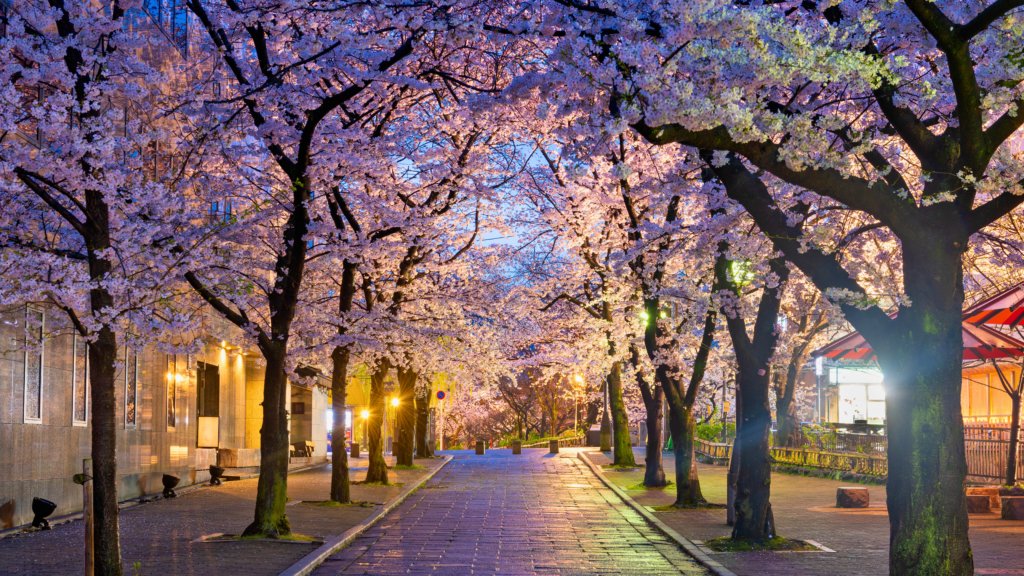
Kyoto is a year-round destination, but each season offers a unique charm. Whether you’re chasing cherry blossoms, fall foliage, or snowy temple scenes, here’s what to expect in every season:
🌸 Spring (March to May) – Cherry Blossom Magic
Spring is one of the most popular times to visit Kyoto, thanks to the spectacular cherry blossoms that bloom in late March to early April. The city comes alive with hanami (flower viewing) picnics, and top spots like Maruyama Park and the Philosopher’s Path are at their most beautiful—though they can get very crowded.
🌡 Temperatures: 8°C to 20°C (46°F to 68°F)
💡 Tip: Visit early in the morning to enjoy Kyoto’s sakura spots with fewer crowds.
☀️ Summer (June to August) – Hot, Humid & Festival Season
Summers in Kyoto are hot and humid, with occasional rain showers. While sightseeing can be intense due to the heat and high humidity, summer is also festival season! The famous Gion Matsuri, held in July, is one of Japan’s most spectacular traditional festivals.
🌡 Temperatures: 22°C to 34°C (72°F to 93°F)
💡 Tip: Stay hydrated and explore early mornings or evenings to avoid the midday heat.
🍁 Autumn (September to November) – Stunning Fall Foliage
For breathtaking fall colors, Kyoto in November is an absolute dream. The fiery red and orange maple leaves create a picture-perfect backdrop at temples like Tofuku-ji and Eikando. The weather is cool, comfortable, and ideal for exploring.
🌡 Temperatures: 10°C to 25°C (50°F to 77°F)
💡 Tip: Kyoto’s autumn foliage peaks in mid to late November, so plan accordingly for the best views.
❄️ Winter (December to February) – Peaceful & Magical Kyoto
Winter is Kyoto’s quietest season, making it a great time to explore without crowds. Occasional snowfall transforms Kyoto’s temples—especially Kinkaku-ji (Golden Pavilion)—into a magical winter wonderland. It’s also the best time to enjoy seasonal delicacies like hot pot dishes.
🌡 Temperatures: 0°C to 12°C (32°F to 54°F)
💡 Tip: Bring warm layers and enjoy Kyoto’s onsen (hot springs) for a relaxing winter experience.
📅 For pleasant weather and fewer crowds, the best times to visit Kyoto are:
✅ Late autumn (mid-November to early December) – for vibrant fall foliage.
✅ Early spring (late March to early April) – for stunning cherry blossoms.
Whichever season you choose, Kyoto’s timeless beauty will make your visit unforgettable! 🌿✨ For more detailed information on the best time to visit Japan, check out our post “Best Time to Visit Japan: Month-by-Month Weather & Travel Guide“.
Where to Stay in Kyoto – Best Areas for Every Traveler
Choosing the right neighborhood to stay in can enhance your Kyoto experience, whether you’re looking for traditional charm, modern convenience, or a peaceful retreat. Here are the best areas to consider based on your travel style:
🏯 Gion & Higashiyama – Best for a Traditional Atmosphere
If you want to immerse yourself in Kyoto’s historic charm, staying in Gion or Higashiyama is the perfect choice. This area is home to Kyoto’s geisha district, with charming wooden machiya townhouses, narrow stone streets, and traditional ryokan (Japanese inns). You’ll also be within walking distance of some of Kyoto’s top attractions, like Kiyomizu-dera Temple and Yasaka Shrine.
✨ Why Stay Here?
✔️ Close to Kyoto’s most scenic and historic sites
✔️ Great for experiencing traditional ryokan stays
✔️ Beautiful at night with lantern-lit streets
🏡 Best for: Travelers who want a classic Kyoto experience
🚶 Nearby attractions: Kiyomizu-dera, Yasaka Shrine, Ninenzaka & Sannenzaka streets
🏙️ Downtown Kyoto (Kawaramachi & Shijo-Dori) – Best for Shopping & Dining
For a lively, modern atmosphere with great food, shopping, and nightlife, Downtown Kyoto (around Kawaramachi & Shijo-Dori) is the best choice. This area offers a mix of hotels, guesthouses, and modern accommodations while close to Kyoto’s bustling entertainment and retail districts.
✨ Why Stay Here?
✔️ Best for restaurants, shopping, and nightlife
✔️ Easy access to public transport for exploring Kyoto
✔️ A mix of budget to luxury hotels
🏡 Best for: Travelers who love city life and convenience
🚶 Nearby attractions: Nishiki Market, Pontocho Alley, Teramachi Shopping Arcade
🚆 Kyoto Station Area – Best for Convenience & Budget Travelers
If you plan to take day trips from Kyoto or want a budget-friendly stay, the Kyoto Station area is a great option. This is Kyoto’s main transportation hub, offering direct access to the Shinkansen (bullet train), buses, and local trains. Hotels here are often cheaper than in central Kyoto, making it a great base for those exploring beyond the city.
✨ Why Stay Here?
✔️ Perfect for day trips to Osaka, Nara, or Himeji
✔️ Budget-friendly hotels and business accommodations
✔️ Close to modern shopping malls and convenience stores
🏡 Best for: Travelers who want affordable stays with great transport links
🚶 Nearby attractions: Kyoto Tower, Toji Temple, Higashi Hongan-ji Temple
🌿 Arashiyama – Best for a Peaceful Nature Retreat
If you’re looking for a quiet, scenic escape, staying in Arashiyama is a fantastic choice. Nestled in Kyoto’s western district, this area is known for its stunning natural scenery, including the famous Bamboo Grove, Katsura River, and Monkey Park. It’s perfect for travelers who want to experience a more tranquil side of Kyoto while still within reach of the main city.
✨ Why Stay Here?
✔️ Surrounded by beautiful landscapes and temples
✔️ Perfect for nature lovers and photographers
✔️ A mix of traditional ryokan and riverside accommodations
🏡 Best for: Travelers seeking a relaxing and scenic stay
🚶 Nearby attractions: Bamboo Forest, Tenryu-ji Temple, Togetsukyo Bridge
🏨 Final Recommendation: Where Should You Stay?
✅ For first-time visitors & cultural immersion: Gion & Higashiyama
✅ For nightlife, dining & shopping: Downtown Kyoto (Kawaramachi & Shijo-Dori)
✅ For budget travelers & easy transport: Kyoto Station Area
✅ For a peaceful, nature-filled retreat: Arashiyama
No matter where you stay, Kyoto’s rich history, vibrant culture, and stunning landscapes will make your trip unforgettable! 🌸🏯
Conclusion – Your Perfect Kyoto Experience
Kyoto is a city where ancient traditions, breathtaking nature, and rich history come together in perfect harmony. This 3-Day Kyoto Itinerary is designed to help first-time visitors experience the best of Kyoto, from its iconic landmarks and serene temples to its cultural treasures and exquisite cuisine.
From wandering beneath the vermilion torii gates of Fushimi Inari Taisha to strolling through the enchanting Arashiyama Bamboo Forest and savoring a refined kaiseki dinner, Kyoto offers a truly unforgettable travel experience. Whether you’re drawn to its fascinating history, picturesque landscapes, or world-class culinary scene, Kyoto has something to inspire every traveler.
✨ Final Travel Tips for Kyoto
✅ Start your mornings early – Beat the crowds at popular attractions like Kiyomizu-Dera and Fushimi Inari Taisha.
🚇 Use Kyoto’s public transportation & rent a bike – Trains and buses are efficient, but exploring on foot or by bike allows you to discover hidden gems.
🍵 Try Kyoto’s local specialties – From yudofu (tofu hot pot) to matcha-infused desserts, Kyoto’s food scene is a delight.
🎎 Respect cultural etiquette – Speak softly in temples, remove shoes in traditional spaces, and be mindful of local customs.
🌸 Plan according to the seasons – Spring for cherry blossoms, autumn for fiery maple leaves, summer for vibrant festivals, and winter for a peaceful retreat.
This 3-day itinerary perfectly balances history, culture, nature, and culinary delights, ensuring you make the most of your time in Kyoto.
💬 Are you planning your Kyoto adventure? Let us know in the comments! Feel free to share your experiences, ask questions, or get more travel tips from fellow explorers. Happy travels! 🚀🏯✨
For more official travel information on Kyoto, visit the Kyoto tourism website.
👉 If you’re planning a longer trip to Japan and want to explore beyond Kyoto, check out our guide to the 15 Best Places to Visit in Japan: Your Ultimate Travel Guide for even more incredible destinations! Our Japan Itinerary for First-Timers shows how to spend 10 incredible days across Tokyo, Kyoto, and Osaka! You can also extend your Japanese adventure by discovering Japan’s incredible off-the-beaten-path spots that few tourists visit.
Don’t forget to follow us on Facebook, Twitter, and Instagram for more travel tips and inspiration.
If this post was helpful, check out our blog for more travel guides and tips!

